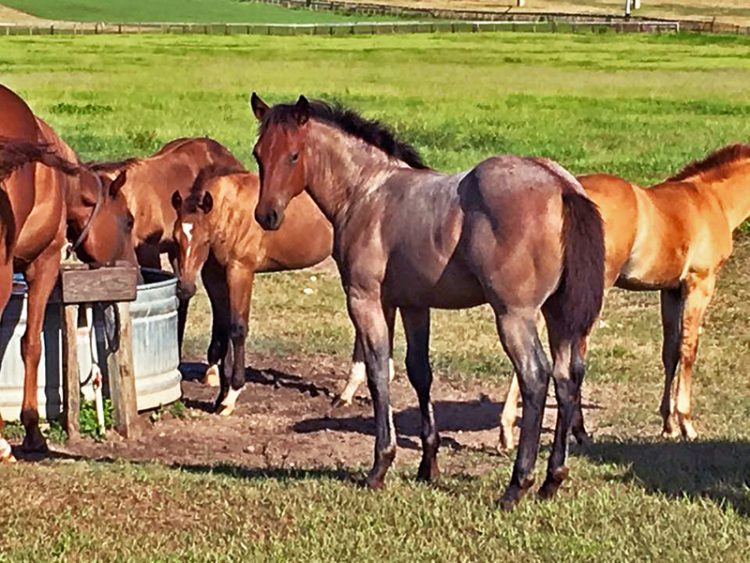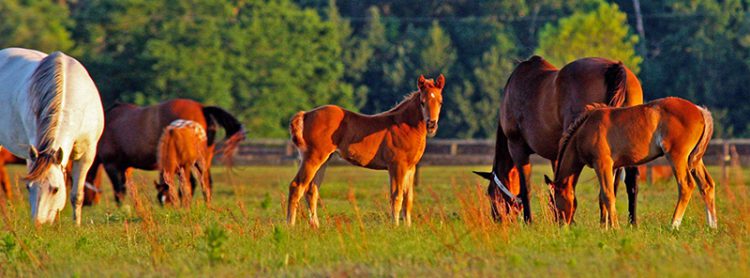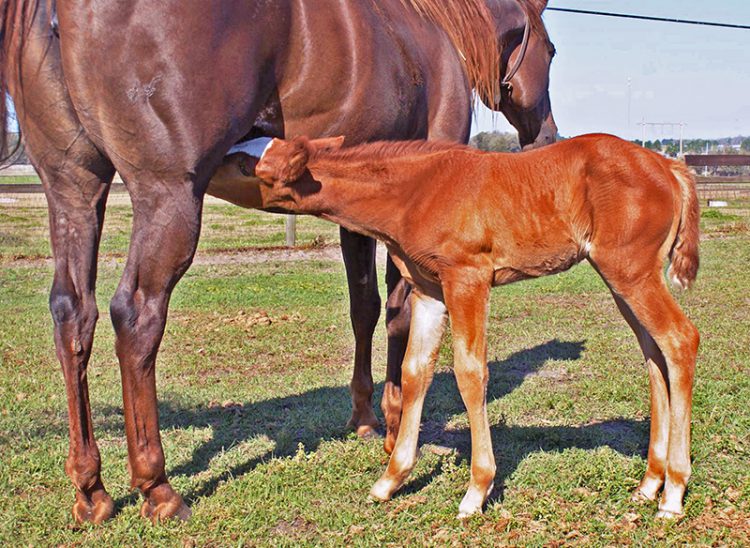Saundra TenBroeck, UF/IFAS State Extension Horse Specialist
Whether you are a small breeder producing one or two foals a year, or a much larger commercial operation, weaning can be a challenging time for the mare, foal and manager. Many factors affect the when, how and where of weaning your foals. Factors include: age of the foal, health, temperament, facilities, management/labor, number of mares and foals, and body condition of mares.
Determining when
During the first six weeks of lactation the quantity and quality of the mare’s milk is at its peak, adequate to meet the foal’s nutritional requirements for optimal growth and development. Subsequently milk production declines gradually over time. After 4 months of age, the foal’s nutritional requirements exceed what is provided in the mare’s milk. Though older foals will continue to nurse frequently throughout the day, a good deal of the nursing is for comfort. Weaning occurs on some farms as early as 3 months and as late as 7 months on others, with the average being 4-5 months. Early weaning might be desirable for mares that have lost excessive body condition during lactation, or if the foal’s weight gain does not meet production performance goals.
–
Preparation for weaning
Preparation is key to preventing problems. Breaking the mare/foal bond will be stressful no matter how or when you do it. Stress suppresses the immune response making animals more vulnerable to disease challenges. Limiting additional stressors at weaning time will allow the mare and foal to better cope with the process.
–
Parasite control
Foals should be dewormed beginning at 2 months and then every 60 days with an appropriate broad spectrum dewormer. An alternative method would be to feed daily dewormer beginning at 2 months. The foal should be weighed, if possible, to assure adequate dose. Remember: underdosing is the fastest way to develop resistant parasites on your farm.
–
Disease prevention
If mares are vaccinated 30 days prior to foaling, the foal will have the best opportunity to get passive immunity from high quality colostrum during the first day of life. Maternal antibodies remain in the foal’s system for several months and will actually block the foal’s ability to respond to vaccines. Depending on what vaccines a mare received pre-foaling, a vaccination program should begin at 3-4 months, followed up by a booster 3-4 weeks later. Core vaccines include tetanus, eastern and western encephalitis, and West Nile virus. If there is a lot of traffic on and off the farm, and/or if the foal will be traveling, you might also vaccinate against the respiratory diseases, influenza, and rhinopneumonitis. If Strangles is a potential threat on your property, vaccinating for strangles is also a good practice. Consult your veterinarian for a comprehensive health care plan.
–
Getting the foal on feed
The foal will begin eating with the mare as early as two weeks old, and feed and forage consumption will increase over time. Providing creep feed to foals is one of the best ways to give the foal a jump start. A pelleted ration containing 14-16 percent protein, 0.7 percent calcium, 0.4 percent phosphorous and a 0.5 percent trace mineralized salt will support the foal’s rapid muscle and skeletal growth. An area where foals can enter and leave at will, but mares are excluded is best. Creep feed should be provided fresh each day at a rate of 1 pound per month of age per foal. Check the feeder twice a day to be sure the feed is eaten. If creep feeding is not an option, utilize a mare/foal ration that the foal can remain on after weaning.
–
Handling
Whenever possible, foals should be haltered the first week after birth. When catching and leading the mare, the foal can be haltered and led alongside her. This helps when the farrier comes, or for doctoring. Some people wait until weaning time to halter break their foals. Depending on the circumstances, this can work well, but a weanling is significantly larger and stronger than a foal. Early experiences will make the process less stressful.
–
Castration
If you are certain that a colt is going to be gelded, the earlier you can do the surgery, the faster the recuperation. Considerations relating to the timing of castration would include: whether or not both testicles have dropped, tetanus immunization status, weather, and fly prevalence.
–
Weaning methods
The process of weaning will be dictated by the number of foals being weaned, facilities available, labor and personal preference.
- Abrupt weaning is the method when the foals are left where they are in a pasture or placed in a stall, and the mares are taken away, out of sight and earshot. Often times 2-4 mares with older, more independent foals leave first, then a week later 2-4 more until all mares are removed. Some farms keep around an older “nanny” mare to live with the weanlings to provide stability when there is a disturbance like an approaching storm. If you only have one foal, weaning in a stall might be the safest option. Foals should be halter broke if possible. Take out buckets and feeders for the first couple of hours until the foal settles, and be prepared to spend time with the foal. Some of the bond can be transferred to the handler and trust can be developed.

An older mare can serve as a “Nanny’ to a group of weaned foals to keep the group calmer. Credit: Katy Bissinger, UF/IFAS
- Gradual weaning is when the mare and foal are on opposite sides of a fence or in adjacent stalls at feeding time. The separation time is increased daily until they are no longer put back together.
- Fence line weaning was investigated in the early 80’s at Texas A&M University. Mares and foals were placed in paddocks where they could see and touch, but the foals could not nurse over 5-9 days. Cortisol levels of foals being weaned utilizing this method were similar to unweaned foals. Not everyone has the type fences that would be safe enough for this method, but it is a low stress method of weaning.
–
Managing the Mare at weaning
Mares should be turned out so that they can exercise. The grain portion of the ration should be decreased or eliminated to facilitate drying off. Grain can be added back as necessary after drying off to manage body condition. Plenty of forage in the form of hay and/or pasture should be available. Watch the mare’s udder for sign of mastitis. Don’t milk out the mare as that will prolong drying off.
–
Take Home Points
- Minimum weaning age is 3 months old, but 4-6 months is preferred.
- The foal should be in good health with good appetite, eating forage and concentrate.
- The foal should be interacting with other foals or a buddy.
- Plan to be around during weaning and interact with the foal.
- Don’t compound weaning stress with other stressors (moving, hauling, illness, parasites, extreme weather, farrier).
- Reduce the mare’s caloric intake at weaning time.
–
Sources:
AAEP – Tom Lenz – https://aaep.org/horsehealth/weaning-your-foal
AQHA.com/premium/eBooks Weaning Foals: Nutrition and Best Practices
Apter R. C., D.D. Householder. Weaning and weaning management of foals: A review and some recommendations. Science Direct. Vol. 16. 1996
McCall CA, Potter GD, Kreider JL, Jenkins WL: Physiological responses in foals weaned by abrupt or gradual methods. J Equine Vet Sci. 1987;7:368.
- End of Life Issues – Euthanasia:A Horse Owner’s Final Act of Care - October 4, 2024
- Economic Impact Study Indicates the Florida Equine Industry Remains Strong - April 12, 2024
- Management Strategies to Prevent Seasonal Impaction Colic in Horses - October 27, 2023


